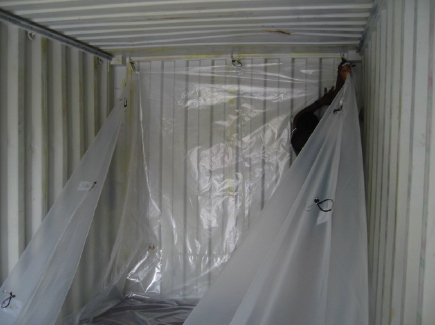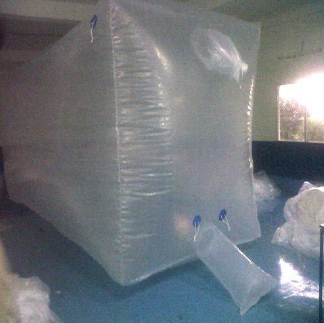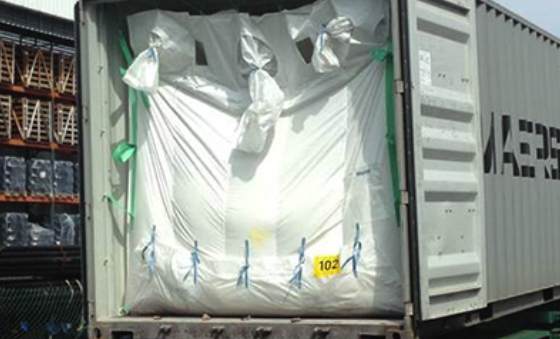Container liners can transform an average 20– or 40–foot container into an efficient transport system for bulk goods within ten minutes. With container liners, every ISO standard container can be used.
Here at TUFBAG, we pride ourselves on being a reliable and dependable container liners supplier.
Our container liners are made from the most high-quality materials so that you rest assured that your product is being transported safely and securely. Container liners are a cost-effective way to ensure that your dry goods stay dry and clean.
Polyethylene Container Liners


Polypropylene Container Liners

Benefits Of Using Liners
Liners are easy and quick to install, and they have numerous benefits. The biggest advantage of liners is that they will ensure that your product is kept safe and that it remains uncontaminated and untainted in any way during shipment.
When container liners are made from quality materials using state-of-the-art manufacturing techniques, they are very durable and can be relied upon not to tear or rupture in transit, thereby keeping your product in good health and avoiding any spillages and wastage.
Container linings also speed up the loading and unloading processes while making sure not to waste any container space, thereby maximising load potential. There is specialised machinery designed to deal with the safe and secure loading and unloading of container liners and their contents, and much of it can be automated. It is more efficient to handle single big loads instead of unloading multiple smaller loads, thereby improving productivity.
Linings also mean that a lot of money is saved on unnecessary additional packaging. Installing one container liner is less costly than using multiple bulk bags or sacks to store smaller portions inside of a container. This is also more environmentally friendly.
The idea behind using container linings – aside from keeping the product safe – is to minimise intermediate handling and enable more efficient transport and handling of bulk cargo. It eliminates the need for container cleaning services, which reduces costs while also reducing dunnage requirements.
This is not only good for the environment, but it is good for the bottom line too.
Linings can be designed to match a variety of needs, with several options being popular on the market for chemicals, food goods, construction materials and more.
Polyethylene Liners
Polyethylene container liners are used typically when transporting fine dry goods such as dried chemical powders, sugar, cement, sand and so on.
The nature of the polyethylene liners is that they don’t breathe and are therefore airtight and watertight. Therefore these liners are great to use with products that are sensitive to moisture and any other potential airborne contamination.
Polyethylene container liners provide a sterile and sealed transportation environment for sensitive goods, giving the supplier and the client peace of mind while the product is in transit.
Polypropylene Liners
Polypropylene container liners are made from a polypropylene weave that is strong and durable but capable of breathing in the case of transporting goods that requires gas exchange during transit. Examples of such products might include grain, nuts, coffee and legumes, among others.
These liners are excellent at protecting the product from spillage and minimising moisture ingress while allowing the product to breathe.
These tough-as-nails liners will ensure that no product gets lost due to spillages and can keep it safe and contained.
FOR FURTHER INFORMATION, PLEASE CONTACT US
FAQs About Container Liners
The choice between these two types of container liners depends on the nature of your cargo. If you need an airtight and waterproof seal for transporting moisture-sensitive products, then polyethylene liners are preferable.
Polypropylene liners, on the other hand, allow for gas exchange, making them better suited for products that need to breathe during transit.
We can customise container liners to meet your specific needs. These can be tailored according to size and can even have special coatings applied or reinforced seams for heavy cargo.
For the most part, our polyethylene and polypropylene liners can be recycled. However, they are generally designed for single use to ensure hygiene and avoid cross-contamination.
Container liners make bulk handling faster and easier by allowing goods to be loaded and unloaded in a single, continuous flow rather than in multiple smaller batches. This reduces handling time, minimises manual labour, and prevents contamination or residue buildup inside the container.
Although container liners are used in many industries, the ones that benefit the most tend to be agriculture, chemicals, construction, and food production. The types of materials transported in these industries are typically sensitive to moisture and air, so contamination control through the use of liners is often crucial.
Affordable container liners eliminate the need for extra individual packaging, reducing costs associated with purchasing bulk bags or drums. Container liners also minimise cleaning costs and prevent product loss, making your transport more cost-effective.
Yes, they do. A container liners manufacturer like Tufbag has anti-static properties, which can be extremely helpful when transporting fine powders or chemical goods that generate static charges.
Yes, they do. A container liners manufacturer like Tufbag has anti-static properties, which can be extremely helpful when transporting fine powders or chemical goods that generate static charges.
Installing a container liner typically takes less than 10 minutes with a small team. They are manufactured to align easily with the container and can be automatically inflated using vacuum systems to speed up the process.
There are specialised liquid liners available on the market. However, the container liners from Tufbag are primarily designed to handle dry bulk goods.
Yes. As a leading container liners manufacturer, we can make sure that our liners are made with food-grade-approved materials to ensure the highest hygiene standards and the safe transport of consumable products.
